Planning and Environment Linkages
PEL
Peer Exchange
August 21-22, 2019
Austin, Texas
Host Agency
Texas Department of Transportation (TxDOT)
Participating Agencies
Alamo Area Metropolitan Planning Organization
Capital Area Metropolitan Planning Organization (CAMPO - Austin)
FHWA Office of Planning
FHWA Office of Project Development & Environmental Review
FHWA Idaho Division
FHWA Montana Division
FHWA Nebraska Division
FHWA Texas Division
Idaho Transportation Department
Montana Department of Transportation
Nebraska Department of Transportation
North Central Texas Council of Governments (NCTCOG)
Texas Department of Transportation
U.S. Coast Guard
U.S. Department of Transportation - Volpe Center
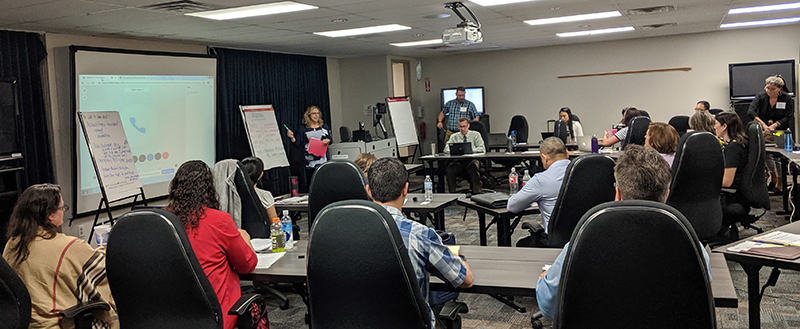
Source: Volpe
This report summarizes the August 21-22, 2019, Planning and Environment Linkages (PEL) peer exchange held in Austin, TX, sponsored by the Federal Highway Administration (FHWA) Office of Planning and the Office of Project Development and Environmental Review. The contents of this document do not have the force and effect of law and are not meant to bind the public in any way. This document is intended only to provide clarity to the public regarding existing requirements under the law or agency policies.
Contents
Background
The following report summarizes a PEL peer exchange coordinated by the FHWA Office of Planning, Environment, and Realty held in Austin, Texas, on August 21-22, 2019. The purpose of the event was to discuss approaches and effective practices for planning and environment linkages (PEL). PEL is a collaborative and integrated approach to transportation decision-making that 1) considers environmental, community, and economic goals early in the transportation planning process, and 2) uses the information, analyses, and products developed during planning to inform the environmental review process. PEL can help transportation agencies achieve efficient environmental review and permitting timelines, which is important to decision-makers and the public. Applying PEL approaches can help agencies create higher quality, more efficient, predictable, and integrated transportation planning and environmental review processes, and can ultimately accelerate project delivery. PEL uses transportation planning to inform the environmental review process required under the National Environmental Policy Act (NEPA).1
This peer exchange was funded through the Second Strategic Highway Research Program (SHRP2) product Expediting Project Delivery (C19).2 C19 is aimed at accelerating planning and environmental review processes for transportation projects. This product identifies 24 strategies for addressing or avoiding 16 common constraints to accelerating project delivery, of which PEL is one. These strategies represent innovative approaches to improve transportation decision-making that result in better projects and environmental outcomes. Applying these proven strategies saves time by allowing agencies to anticipate and reduce project delays in a collaborative manner with key partners and stakeholders.
↑ Back to top
Introduction
The FHWA Texas Division and the Texas Department of Transportation (TxDOT) hosted the event in coordination with FHWA Office of Planning and Office of Project Development and Environmental Review. Attendees included representatives from FHWA division offices, State
DOTs, and metropolitan planning organizations (MPOs) from Texas, Nebraska, Montana, Idaho, and Florida. Participants from these organizations who were unable to join the peer exchange in-person were able to participate remotely via WebEx. The focus of the peer exchange was to discuss each state’s PEL approach, share best practices, and advance PEL implementation.
This document summarizes the peer exchange. The agenda is available in Appendix A and a list of participants is available in Appendix B. Presentations referenced in this event summary are available upon request.
↑ Back to top
Peer Exchange Summary
Day 1: PEL Overview and Discussion
Opening Remarks
Peter Smith, Director of TxDOT’s Transportation Planning and Programming Division, and Marcus Wilner, Chief Operating Officer of the FHWA Texas Division, opened the peer exchange by welcoming participants to Texas. Mr. Smith noted that Texas has been doing corridor studies, which are similar to formal PEL studies, for a long time; however, he also said that TxDOT is always learning and that he looked forward to learning along with the other participants. Mr. Wilner thanked staff at the FHWA Texas Division and the U.S. DOT Volpe Center for organizing the peer exchange.
Defining PEL
Jody McCullough of the FHWA Office of Planning and Lana Lau of the FHWA Office of Project Development and Environmental Review presented on the authorities under which PEL approaches can be used and on other Federal regulations and initiatives related to PEL. Ms. McCullough presented first, explaining that PEL considers environmental, community, and economic goals early in the transportation planning process. She also showed a video explaining PEL.3 PEL uses the information, analysis, or products developed during planning to inform the environmental review process, including the NEPA process. Use of PEL is not required for project development; however, if it is used, PEL planning products (planning analysis and/or planning decisions), including development of purpose and need and elimination of unreasonable alternatives, may be adopted or incorporated by reference as long as these products meet NEPA requirements, or may be used to inform the NEPA process. Transportation planning activities undertaken as part of the planning process prior to the initiation of NEPA are eligible for Planning (PL) and State Planning and Research (SPR) funds, which is a major benefit of the PEL process. Additional benefits of PEL include reduced duplication, cost and time savings, enhanced community involvement, and improved relationships and coordination.
Many of the conditions for PEL are already completed as part of the normal transportation planning process. General considerations for early in the process, which may make it easier to meet the conditions for planning products to be carried forward into NEPA, include developing cooperative relationships, sharing publicly available information, having reliable data, developing and using reasonable methodologies, establishing sufficient documentation, and engaging FHWA Division or Federal Transit Administration (FTA) Region Offices, as necessary.
Ms. McCullough further elaborated on the benefits of PEL. She explained that a key benefit of PEL is minimizing the duplication of efforts. Under a PEL approach, information and analysis completed during planning can be used during project development and in the environmental review process, improving efficiency and accelerating overall project delivery. Using a PEL approach may also involve early public involvement and early coordination with resource agencies, both of which can also provide additional benefits, such as building better relationships. Ms. McCullough also addressed litigation risks. She noted that planning activities are not considered Federal actions subject to review under NEPA, but when planning products are used in NEPA, they may be subject to future litigation.
Ms. Lau provided a more detailed overview of PEL approaches and the authorities and conditions associated with each of them (Figure 1). PEL is referenced in both planning and environment statutes, regulations, and guidance. The Council on Environmental Quality (CEQ) 40
USC
1500.54 provides regulations on the process of implementing NEPA. The CEQ regulations include incorporating NEPA into early planning and the incorporation by reference of information that will “cut down on bulk.” 23 USC 168 and 23 USC 139(f)(4)(E),5 allow FHWA and FTA, as NEPA lead agencies, to use the results or decisions of State DOTs, MPOs, or public transportation operator-led corridor and subarea planning studies in the environmental review process under NEPA so long as these results or decisions meet NEPA requirements.
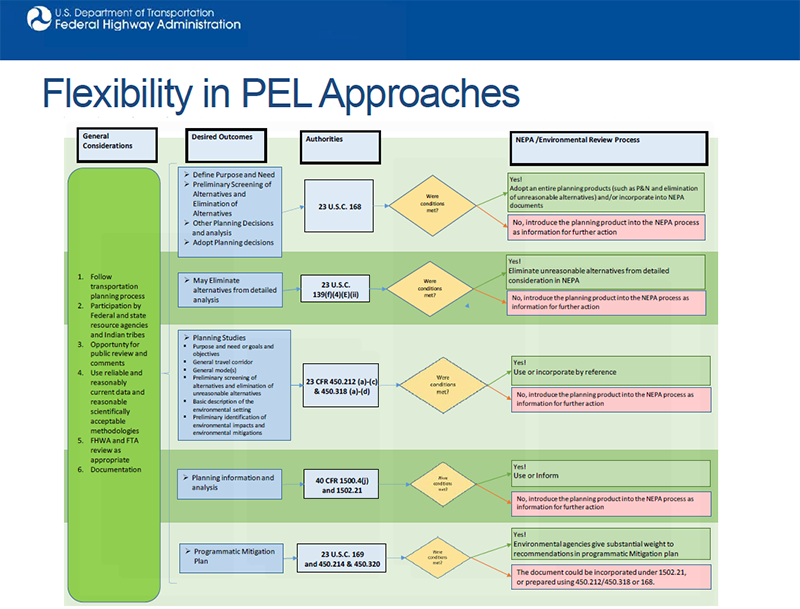
Figure 1. PEL Authorities
An optional statutory process for the integration of planning and environmental review was introduced in MAP-21 and amended by the Fixing America’s Surface Transportation (FAST) Act and codified in 23 USC 168. Adoption of planning products or incorporation by reference can occur under PEL if the 10 conditions set forth in 23 USC 168(d) are met. Elimination of an unreasonable alternative can occur as outlined in 23 USC 139(f)(4)(E)(ii). As long as conditions are met under either of these statutes, the ability to use planning products in NEPA is preserved. Many of the conditions for PEL are completed during the normal transportation planning process. However, there are oversight responsibilities that field staff must ensure are adhered to for planning products to be viable for use in the environmental review process.
Alternatively, if a State is interested in incorporating PEL to their planning process, corridor and subarea studies as discussed in 23
CFR
450.212(a)-(c)6 and 23 CFR 450.318(a)-(d)7 can be used to produce a wide range of analyses or decisions for FHWA/FTA review, consideration, and possible adoption in the NEPA process for an individual transportation project.
Ms. Lau also presented on One Federal Decision (OFD). Executive Order 13807,8 Establishing Discipline and Accountability in the Environmental Review and Permitting Process for Infrastructure Projects, requires Federal agencies to process environmental reviews and authorization decisions for “major infrastructure projects” as OFD and sets a government-wide goal of reducing, to two years, the average time for each agency to complete the required environmental reviews and authorization decisions for major infrastructure projects, as measured from the date of publication of a notice of intent to prepare an environmental impact statement. The benefits of PEL support the goals of Executive Order 13807, which emphasizes early and ongoing coordination, concurrent agency reviews with timely permitting and agency decisions, and issuing one federal decision document (the Record of Decision) to the maximum extent practicable.
Question and Answer
Q: Does the term “to inform” NEPA, when referring to a planning product, mean something different than “to use” in NEPA? If a planning product is used “to inform,” is it subject to potential litigation in NEPA?
A: If a planning product is used to inform NEPA, it will not be part of the technical file. Instead, when used to inform, a planning product’s information is used to provide background and input for NEPA analysis. Typically, a product used to inform is not adopted because it may not meet the regulations for NEPA quality and may need further analysis in NEPA. Because it is not adopted into NEPA, it is not as likely to be subject to litigation.
Q: Have there been any lawsuits filed on a PEL study itself?
A: A NEPA decision must be made in order to be subject to litigation. Because a PEL study does not deliver a decision, a lawsuit challenging a PEL study’s findings would be against the NEPA decision, not the PEL study itself. Case law on the issue of the use of transportation planning studies and decisions in the NEPA process is not extensive. However, to the extent they exist, court decisions have consistently supported the reliance in the NEPA process on work done in the planning process.
Resources
Resources highlighted during this presentation included:
PlanWorks PEL Application Demonstration
Cheng Yan of the FHWA Office of Planning presented on PlanWorks,12 an online tool that supports collaborative decision-making in transportation planning and project development. Built around key decisions in long-range planning, programming, corridor planning, and environmental review, PlanWorks suggests when and how to engage cross-disciplinary partners and stakeholder groups. Mr. Yan explained that PlanWorks is a full suite of tools touching on topics such as performance measures, visioning, freight, health, and other topics, but that the corridor planning and environmental planning components are likely the most relevant to PEL activities and implementation. He specifically pointed out the assessment tool, which offers a way to pinpoint potential program risk areas and a way to identify opportunities to work together to improve interagency cooperation and expedite project delivery.
Mr. Yan provided a live demonstration of the PlanWorks assessment tool (Figure 2). He walked through how to do an assessment to show how practitioners may use the tool in the course of their work in implementing PEL approaches.
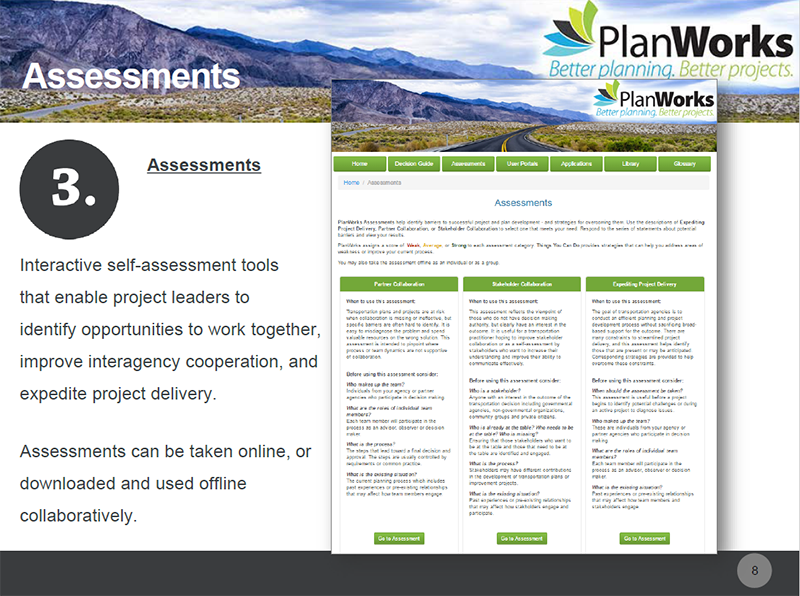
Figure 2. PlanWorks Assessment Tool
State Overviews of PEL Approaches
Following the presentations from FHWA staff, each state presented a short overview of the PEL approaches used in their state to date.
Texas Overview of PEL Approaches
Roger Beall, Deputy Director of TxDOT’s Transportation Planning and Programming Division, presented on PEL approaches in Texas. Texas is relatively new to the PEL process, having completed a formal PEL study in 2013, but otherwise having not regularly used the formal PEL process on a statewide basis. He said that there are several ongoing PEL studies now, however, including in Houston and Austin.
In the past, Texas has used a “PEL-like” study approach for many of their projects. This approach involves completing planning studies with NEPA in mind in order to create documentation that can be carried forward into NEPA. For the most part, these studies have been smaller corridor studies while the formal PEL process has been reserved for larger projects. One of these projects, the I-35 northeast expansion in San Antonio, was the first PEL study in the state, conducted between 2011 and 2013. In this study, Texas eliminated some unreasonable alternatives, which helped to narrow the focus of the study, resulting in an accelerated NEPA process.
Anita Bradley, Environmental Specialist in TxDOT’s Environmental Affairs Division, followed Mr. Beall’s introduction with a presentation focusing on some other PEL studies completed in Texas. Ms. Bradley stated that Texas has three ongoing PEL studies currently in their first phase. Texas is using PEL authority under 23 CFR 450.212 to guide these studies to inform the NEPA process. One of these studies is focusing on the I-10 east corridor from I-69 to Texas state highway 99—a 17-mile corridor that is very important to freight and oil movement and that also serves as a hurricane evacuation route. Currently, Texas is completing data collection, analyzing existing conditions, and is very engaged with the public as a part of this PEL study.
Texas has learned several lessons so far based on their experiences with PEL. They have learned that they could benefit from more training and communication across all parties involved with the environmental review process. They have also learned that improving coordination with resource agencies is an important area of focus for them going forward.
Question and Answer
Q: How has Texas managed expectations in public outreach activities?
A: We try to be very honest with folks. We explain that we are doing a planning study, which takes 2-3 years, followed by environmental review, for another 2-3 years, and that we do not yet have funding for construction at the planning study stage. We also visually show the process on a board at many of our public meetings, which helps, though we still have people ask when we will be building the project.
Nebraska Overview of PEL Approaches
Todd Hill, Project Studies and Environmental Engineer for Nebraska DOT, presented on PEL approaches in Nebraska. He noted that PEL approaches are new in Nebraska, as only one PEL study has been completed in the state to date, in 2016. That PEL study was conducted for a corridor in Lincoln, NE, called 33rd and Cornhusker. Nebraska DOT viewed the PEL study as a success, as the project included successful interactive public involvement and resulted in the identification of 11 alternatives, with two recommended alternatives (Figure 3). In 2017, the City of Lincoln decided to pursue a subarea plan for the corridor, resulting in the introduction of 28 additional alternatives. Discussions are ongoing between the City, Nebraska DOT, and the FHWA Nebraska Division about how to proceed given that the PEL study was not completed concurrently with the subarea plan.
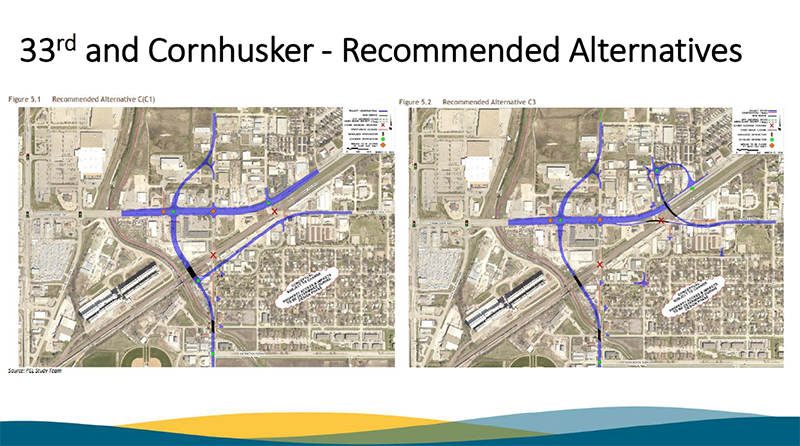
Figure 3. Recommended Alternatives from 33rd and Cornhusker PEL Study in Lincoln, Nebraska
Idaho Overview of PEL Approaches
Karen Hiatt, Engineering Manager with the Idaho Transportation Department, presented on PEL approaches in Idaho. Ms. Hiatt noted that Idaho is new to PEL approaches. Idaho undertook their first PEL study in Idaho Falls with a study involving the US 20 corridor, which is a congested area with high volumes of traffic that can sometimes back up onto the interstate. As a part of the PEL study, three public meetings have been held, and 14 alternatives were identified. Following alternative screening, the number of alternatives was reduced to nine. Idaho is currently collecting additional data, which will be used for further alternatives analysis.
Ms. Hiatt noted that Idaho has identified several challenges as a part of their first PEL study. In particular, they have had difficulty with public understanding of what a PEL study is and how it differs from a project.
Montana Overview of PEL Approaches
Vicki Crnich, Transportation Planner at Montana DOT, and Katie Potts, Transportation Planner at Montana DOT, presented on PEL approaches in Montana. They explained that Montana has been using PEL approaches since 2007 through the use of corridor studies. The outcome of these corridor studies is a range of alternatives or improvement options that could be implemented. Montana has completed 32 of these corridor studies since 2007.
From their experience, Montana has found that corridor studies make it easy to screen out alternatives and/or identify fatal flaws based on financial and environmental constraints. They also allow for a tailored level of analysis specific to the needs and objectives of individual corridors rather than the comprehensive assessment that would otherwise be required under NEPA. They have also found that corridor studies can reduce costs by reducing the number of alternatives evaluated in NEPA, by scoping the project at the appropriate level and by identifying fatal flaws before entering the NEPA process.
Ms. Crnich and Ms. Potts also shared that Montana has learned several lessons from their corridor study process. They have found that a flexible process rather than a one-size-fits-all approach works better (Figure 4). They have also found that it is important to keep the technical oversight committee on each project involved, as well as to thoroughly document public involvement and resource agency consultation. In some cases, the no-build option may be the best option.
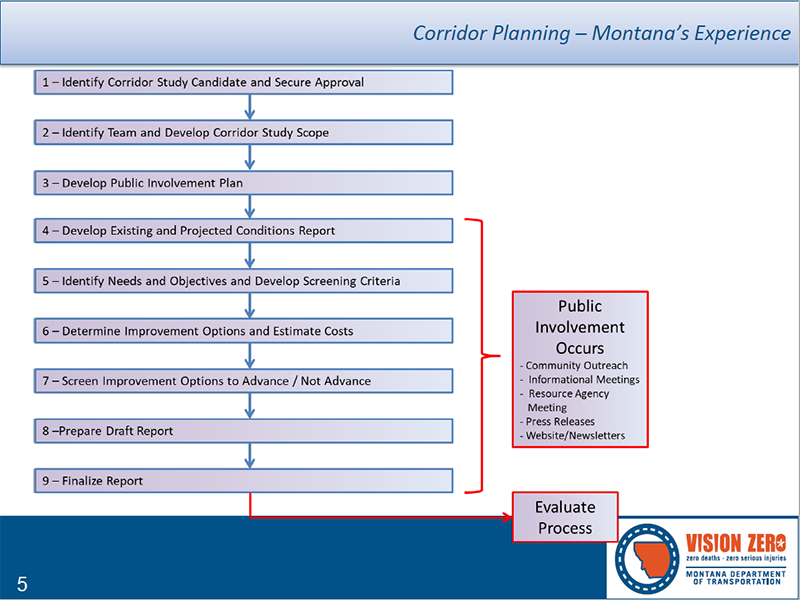
Figure 4. Montana’s Corridor Planning Process
Florida Overview of PEL Approaches
Peter McGilvray, State Environmental Quality and Performance Administrator with Florida DOT, presented on PEL approaches in Florida. Florida has institutionalized a PEL approach through their Efficient Transportation Decision-Making (ETDM) process. The ETDM process is how Florida DOT incorporates environmental considerations early into transportation planning to better inform project delivery. During ETDM, Florida DOT identifies potential environmental impacts and asks for input from agencies and the public.
To facilitate intergovernmental interactions, each of the seven Florida DOT districts has an Environmental Technical Advisory Team (ETAT). ETAT members and the public have the opportunity to provide input on a project’s potential effects on the natural, physical, cultural, and community resources throughout the planning phase of project delivery.
Under the ETDM process, projects undergo two screening events: a planning screen and a programming screen (Figure 5). During the planning screen, comments received from ETAT members and the public help Florida DOT identify environmental considerations to assess projects for inclusion or advancement in the long-range transportation plan (LRTP). During the programming screen, qualifying projects are reviewed when being considered for funding in the Florida DOT Five-Year Work Program or MPO Transportation Improvement Program (TIP), or if already funded, before advancing to the project development and environment study stage.
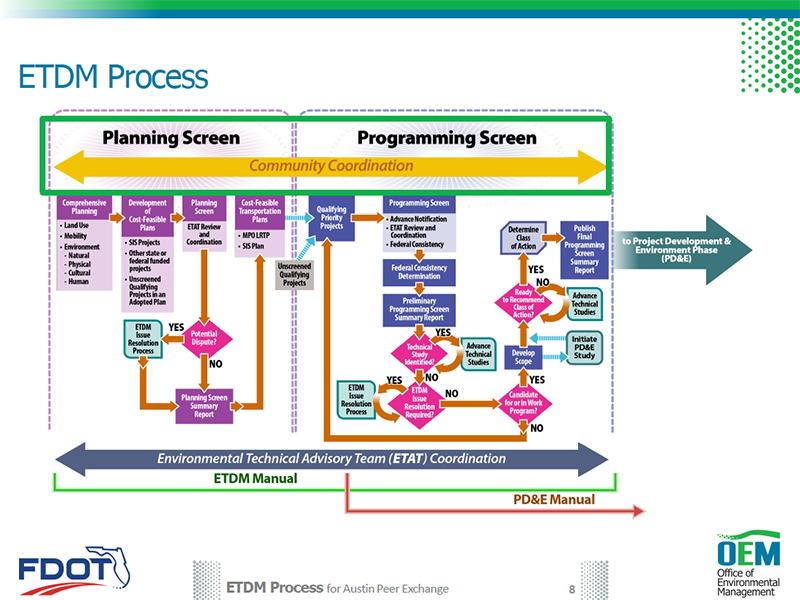
Figure 5. Florida DOT’s ETDM Process
Coordination with the ETAT members is facilitated through the Environmental Screening Tool (EST),13 an Internet-accessible interactive database and mapping application. The EST brings together resource and project data from multiple sources into one consistent format. It provides quick, standardized GIS analyses, identifying potential natural, physical, cultural, and community resources present in the project area. The EST also allows the ETAT members the opportunity to provide input on proposed projects.
Florida DOT has formalized the ETDM process through state and federal resource agency agreements, training programs, and policies and procedures. One way Florida DOT has done this is to use federal funding for liaison positions at resource agencies.
Question and Answer
Q: You mentioned it took 15 years to get to this point. How much did it cost you to implement this process?
A: At this point, everything is just maintaining what we have. That maintenance costs about $500,000 per year. The initial start-up took two years, and our estimates were that creating the process itself was $1 million, plus $2.5 million to get from start-up to the first screening.
Participant Dialogue: Framing the Discussion on PEL Benefits and Challenges and Roles and Responsibilities
Following presentations by the peers, Rachael Sack of the U.S. DOT Volpe Center facilitated a discussion session during which attendees discussed the following topics:
- Public involvement
- Resource agency coordination and liaison positions
- Developing purpose and need
- Moving from a PEL study into NEPA
Public involvement was a prominent theme and topic of focus for the group discussion. Participants shared their experiences with public involvement during PEL and the challenges and strategies they have used. Participants noted that a challenge with public involvement during a PEL study is explaining that it is a study and that there is not construction funding or a planned project at the PEL study stage. Participants also shared that it is hard to know how much public involvement is enough. FHWA representatives mentioned the virtual public involvement initiative,14 which aims to leverage digital techniques to improve public engagement. An MPO representative with experience using virtual public involvement shared that social media advertising targeting can be very cost-effective and comes with better metrics than other traditional engagement mechanisms, such as sending mailings, which can be very expensive.
In terms of resource agency coordination, participants were interested in Florida DOT’s approach of using funded liaison positions at resource agencies to improve coordination and cooperation. Florida DOT spends $2.5 million of Federal §139(j) funds15 annually to fund their liaison positions. Many State DOTs may not be aware that this funding can be used to fund resource positions. Florida DOT noted they have had great success and would recommend other State DOTs use their §139(j) funding to fund liaison positions.
Montana DOT shared that they had previously had a good process to engage resource agencies, but that their process has become strained as resource agencies have become busy and understaffed. The U.S. Coast Guard liaison shared that she is happy to be a resource for State DOTs to facilitate conversations with national liaisons and to identify appropriate contacts in order to improve resource agency coordination and cooperation.
Participants discussed the level of detail required in the purpose and need statement and how that level of detail might vary or change between a PEL study and entering the NEPA process. They shared that it can be challenging to determine the appropriate level of specificity during a PEL study. Because a PEL corridor study can be quite large, a single purpose and need for the entire corridor can be challenging to identify. A purpose and need cannot be too general because then it does not provide the appropriate basis for decision-making. If it is difficult to determine screening criteria by which to evaluate alternatives, that is likely a sign that the purpose and need should be more specific. It can also be an iterative process to develop an appropriate purpose and need.
When a PEL study is completed, there is not an official sign-off. Because there is not an official approval step, participants were not sure how to proceed into NEPA. FHWA staff stated that as long as the NEPA quality and appropriate documentation is there for PEL study products, all or part of those products can considered in NEPA for adoption as is and/or to inform the process during environmental review. They also stated that each state may have a different context, depending on whether a state has NEPA assignment and what the relationships are like within a given state. Different states have also developed different approaches to acknowledging PEL studies, as there is no regulatory requirement for an FHWA division office to sign off on a PEL study’s findings, nor should an FHWA division office be making a decision or approval that could be considered a Federal action at this point in the process. However, states are encouraged to coordinate with their FHWA division when working on a PEL study, as appropriate.
Day 2: Adopting PEL Approaches to Processes and Projects
Group Discussion: Integrating PEL with Planning and Other Processes
Ms. Sack facilitated a discussion session focused on how PEL can integrate with planning and other processes (Figure 6). The discussion focused on the following key questions:
- How does planning at the MPO level integrate with state processes when using PEL approaches?
- How can PEL and PEL studies be linked to LRTP processes?
- How can or does land use decision-making interact with PEL?
- What successful practices have states used to reach environmental justice (EJ) populations?
How does planning at the MPO level integrate with state processes when using PEL approaches?
MPO representatives noted that every MPO is different in size and operations. In Texas, the large MPOs maintain their own travel demand models, which form the basis of PEL studies, which are led by TxDOT. In Florida, MPOs work with Florida DOT districts to identify priority projects that will go into the LRTP and enter the ETDM planning screen. Participants expressed that one challenge is that different MPOs have different levels of technical skills and resources, which may impact how involved an MPO and its staff can or will be with a PEL study.
How can PEL and PEL studies be linked to LRTP processes?
Participants noted that how PEL approaches and PEL studies are linked to LRTP processes will differ depending upon the type of PEL study being conducted. For project-specific PEL studies, those projects are likely in the LRTP, but for corridor studies, the potential projects within that corridor may not be in the LRTP, as specific projects may not have yet been identified. Participants noted that having clearly documented processes to follow can help mitigate confusion and create consistency in how PEL studies are conducted and how they can feed into or relate to LRTPs. Participants also noted that LRTPs typically exist as policy documents, which may limit how LRTPs can relate to PEL studies. Utah was identified as an example of a state where specific projects identified from MPOs were combined into a unified statewide plan that compliments its policy-driven LRTP.
How can or does land use decision-making interact with PEL?
Participants stated that land use should be built into regional travel demand models, which should provide a basis for PEL studies, aiding with the integration of land use decision-making into the PEL process. In Florida, data from two state agencies—the Department of Economic Opportunity and Department of Community Affairs—are incorporated into the ETDM programming screen to determine if proposed projects are consistent with local land use and other plans.
What successful practices have states used to reach EJ populations?
In Florida, community liaison coordinators assist with the identification of EJ populations. Following the identification of these communities, plans are developed for targeted outreach to ensure engagement. In Texas, TxDOT maintains contracts with consultants to carry out public engagement for PEL studies. The consultant develops plans for EJ communities and then implements the plans to do outreach. Each project and each population is unique, so the approaches vary from project to project and community to community to meet individual needs.
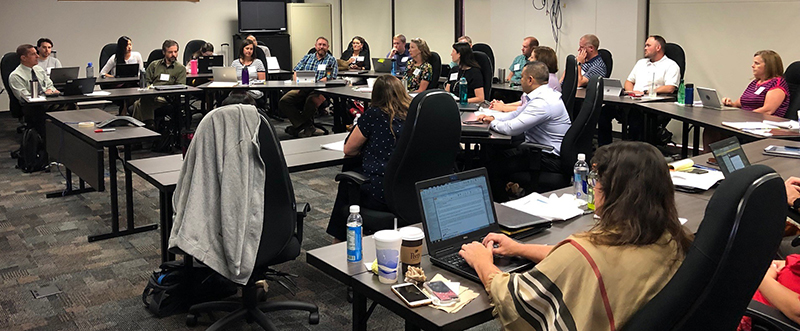
Figure 6. Participants Engaged in Group Discussion (Source: FHWA)
Group Discussion: Considerations for Implementing PEL Approaches
Ms. Sack facilitated a discussion session focused on considerations for implementing PEL approaches. The discussion focused on the following key questions:
- How do you manage the public’s expectations?
- What are best practices to managing consultants during the PEL process?
- How can PEL be implemented at the project level?
How do you manage the public’s expectations?
One strategy participants identified in order to manage public expectations it to avoid the use of the word “project” when talking about PEL studies. Because “project” can imply construction or that a clear project plan has been identified, the public may associate it with imminent construction. By contrast, using “study” can emphasize that no construction is currently planned, but rather that additional study is being conducted and public input is being sought to inform that study. Participants also said another strategy can be to recap the process at every public meeting, emphasizing the overall timelines and where in the process you are at that given public meeting.
What are best practices to managing consultants during the PEL process?
Montana DOT developed a guidebook for their consultants. They found that useful at the beginning, but now they are seeing that consultants are following the same formula for all projects and are not necessarily delivering the quality Montana would like to see. In Texas, TxDOT previously held workshops for consultants on documentation for a variety of environmental compliance projects in order to ensure consultants understood what TxDOT wanted and the level of quality expected in documentation. MPO representatives noted they use an oversight committee structure to engage government entities but also to provide contract review and oversight for projects. Participants also expressed an interest in having FHWA provide more training to consultants.
How can PEL be implemented at the project level?
Florida maintains over 550 data layers in conjunction with the University of Florida. These data layers are provided and updated by respective agencies, who then use that data for their analysis related to the ETDM process. Florida has found this to be integral to their process, as it allows each resource agency to use their own data as a part of the ETDM process.
Conclusions from Large Group Discussions and Next Steps
Following the group discussions, each state identified their key takeaways from the peer exchange. The states indicated that they will use their key takeaways as considerations for how to further implement or refine their implementation of PEL approaches in their states. Each state’s key takeaways are summarized below.
- Texas: The level of communication is high in states such as Florida with institutionalized PEL approaches. In Texas, there are silos within and between organizations, even within TxDOT, and that limits communications. With 25 TxDOT districts, all of which do their own contracting, it is difficult to communicate and have consistent processes. TxDOT participants intend to look more at our silos and to identify how they can have a better PEL approach.
- Nebraska: The key question for Nebraska coming into this peer exchange was about how to do a PEL amendment. Nebraska participants expressed now understanding that they likely do not need a PEL amendment, but can note changes to underlying conditions in the NEPA document. Another key takeaway was that some states are using PEL at the corridor level rather than the project level. That idea is interesting to Nebraska, and they hope to explore it more.
- Idaho: The PlanWorks assessment tool is a resource that could advance Idaho’s PEL implementation. Idaho also identified that they could benefit from convening their engineers, planners, and environmental professionals to better coordinate on PEL, as well as to engage executive management. They also expressed a strong interest in conducting more PEL studies in Idaho.
- Montana: Typically, PEL studies in Montana have been done at the corridor level. After the peer exchange, however, Montana is now considering the potential benefits of doing a project-level PEL study. They also have new strategies to explore for re-engaging resource agencies where it relates to PEL studies.
↑ Back to top
Closing Remarks
Ms. Sack thanked everyone for their attendance and participation in the peer exchange. She also encouraged participants to stay in contact with FHWA about the tools they need related to PEL and to use PlanWorks to advance PEL approaches.
↑ Back to top
Appendix A - Agenda
| Day 1 - Wednesday, August 21, 2019 |
| Time |
Session - Orientation and Introduction to Content |
| 8:30 A.M. - 8:45 A.M. |
Opening Remarks
- Peter Smith, P.E., TxDOT Transportation Planning and Programming Division Director
- Marcus Wilner, Chief Operating Officer, FHWA Texas Division
|
| 8:45 A.M. - 9:00 A.M. |
Introductions
|
| FHWA PEL Overview |
| 9:00 A.M. - 10:00 A.M. |
Defining PEL
FHWA will provide an overview of the legislative basis for PEL and review primary examples of planning products (analyses and decisions)
- Jody McCullough, FHWA Office of Planning
- Lana Lau, FHWA Office of Project Development and Environmental Review
|
| 10:00 A.M. - 10:30 A.M. |
FHWA Q&A |
| 10:30 A.M. - 10:45 A.M. |
Break |
| 10:45 A.M. - 11:45 A.M. |
PlanWorks PEL Application Demonstration
- Cheng Yan, FHWA Office of Planning
|
| 11:45 A.M. - 1:00 P.M. |
Lunch |
| Peer Overview |
| 1:00 P.M. - 2:00 P.M. |
Overview of PEL Approaches - Participant States (15 minutes each)
- Texas, Nebraska, Idaho, Montana
|
| 2:00 P.M. - 2:30 P.M. |
Overview of PEL Approaches - Florida DOT
- Pete McGilvray, State Environmental Quality and Performance Administrator, FDOT
|
| 2:30 P.M. - 2:45 P.M. |
Break |
| Discussion |
| 2:45 P.M. - 4:00 P.M. |
Participant Dialogue: Framing the Discussion on PEL Benefits and Challenges and Roles and Responsibilities
Facilitated discussion to dig deeper into the materials presented by State DOTs and FHWA Headquarters
|
| 4:15 P.M. - 4:30 P.M. |
Preview of Day 2
|
| Day 2 - Thursday, August 22, 2019 |
| Time |
Session - Adopting PEL Approaches to Processes and Projects |
| 8:30 A.M. - 9:00 A.M. |
Introductions and Day 1 Review
|
| 9:00 A.M. - 10:00 A.M. |
Group Discussion: Integrating PEL with Planning and Other Processes
How can PEL and PEL studies be linked to long-range transportation planning processes?
How can/does land use decision-making integrate or interact with PEL approaches?
How does planning at the MPO level integrate with State processes when using PEL approaches?
How does proceeding into NEPA occur following completion of a PEL study?
- Rachael Sack, Volpe and Pete McGilvray, FDOT
|
| 10:00 A.M. - 10:15 A.M. |
Break |
| 10:15 A.M. - 11:15 A.M. |
Group Discussion: Considerations for Implementing PEL Approaches
What tools are available from FHWA or other States for managing and implementing PEL approaches?
What are the best practices for developing PEL consultant contracts and managing PEL consultants?
What are the best ways to communicate about PEL approaches to agency leadership?
What are the best ways to manage expectations with the public when implementing a PEL study?
How can PEL be implemented at the project level?
How does proceeding into NEPA occur following completion of a PEL study?
- Rachael Sack, Volpe and Pete McGilvray, FDOT
|
| 11:15 A.M. - 11:30 A.M. |
Conclusions from Large Group Discussions
As a large group, highlight key takeaways and identify action items for participating States.
- Rachael Sack, Volpe and Pete McGilvray, FDOT
|
| 11:30 A.M. - 11:45 A.M. |
Next Steps
|
| Closing Remarks |
| 11:45 A.M. - 12:00 P.M. |
Closing Remarks
|
↑ Back to top
Appendix B - Participant List
| First Name |
Last Name |
Organization |
| Jon |
Barber |
Nebraska DOT |
| Roger |
Beall |
TxDOT |
| Anita |
Bradley |
TxDOT |
| Susan |
Chavez |
TxDOT |
| Ryan |
Collins |
Capital Area MPO (CAMPO) |
| Travis |
Crayton |
U.S. DOT Volpe Center |
| Vicki |
Crnich |
Montana DOT |
| Kirk |
Fauver |
FHWA Texas Division |
| Hope |
Gerstler |
U.S. Coast Guard |
| Tom |
Gocksch |
Montana DOT |
| Ryan |
Hammon |
FHWA Montana Division |
| Karen |
Hiatt |
Idaho Transportation Department |
| Todd |
Hill |
Nebraska DOT |
| Brent |
Inghram |
FHWA Idaho Division |
| Lindsey |
Kimmitt |
TxDOT |
| Caleb |
Lakey |
Idaho Transportation Department |
| Lana |
Lau |
FHWA Office of Project Development and Environmental Review |
| Kyle |
Liebig |
Nebraska DOT |
| Amanda |
Long-Rodriguez |
North Central Texas Council of Governments (NCTCOG) |
| Justin |
Luther |
FHWA Nebraska Division |
| Isidro |
Martinez |
Alamo Area MPO |
| Jody |
McCullough |
FHWA Office of Planning |
| Peter |
McGilvray |
Florida DOT |
| Katie |
Potts |
Montana DOT |
| Rachael |
Sack |
U.S. DOT Volpe Center |
| Peter |
Smith |
TxDOT |
| Wendy |
Terlizzi |
Idaho Transportation Department |
| Sue |
Theiss |
TxDOT |
| Peggy |
Thurin |
TxDOT |
| Cheng |
Yan |
FHWA Office of Planning |
↑ Back to top
Footnotes
↑ Back to top

